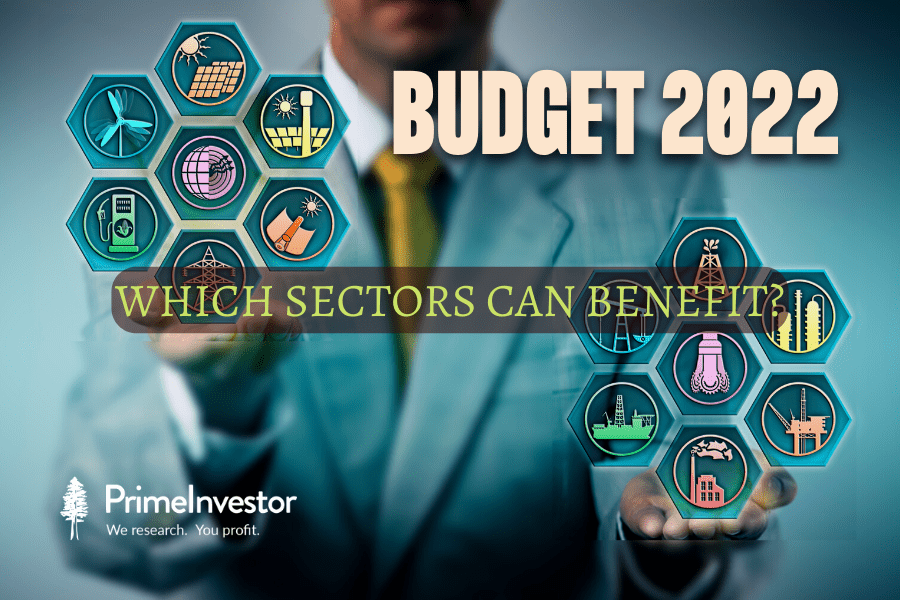Budget 2022 may have only a lukewarm impact on India Inc., with the only silver lining coming from continued thrust on capex spending. Besides this, a more coordinated approach to implementation of infrastructure connectivity through the Gati Shakthi programme (bringing 16 ministries under one platform), incentivizing investment through the Production Linked Incentive (PLI) schemes and pushing local manufacturing through a combination of important substitution (hikes in import duties) and other policy measures are expected to spur economic activity.
Several sectors can benefit from the above measures, but none to any major degree. So, we will restrict this article to a select few sectors that can benefit; these being sectors that we are also focusing on or watching for opportunities.

Capex spending – high and yet not really high!
It is now clear that capex spending is what the government seems to be counting on to push overall economic activity as there appears very little thrust on a consumption push to aid economic recovery. But even this is more measured given that capital expenditure from PSEs is down. Let us quickly take stock of the spending before getting into a few sectors that could see a positive impact from budgetary spending or sops.
The budgetary capex spending for FY23 budget estimate (BE) is projected to increase by 24.5%. This is still lower than the revised estimate of 44% for FY22. Another leg for capex which comes from grants (but under revenue expenditure) also provides funds for capex. Adding that, the FY23BE comes to 27% growth. Good, so far.
However, when we add capex spent by the public sector, the picture looks a lot less rosy. The total capex spend including revenue grants and spending by public sector companies brings the FY23BE capex spending growth to just 14%!
In other words, there is a decline in public sector spending for the upcoming fiscal year. This brings the total capex as a percentage of GDP to 6%. And how does this compare with the previous 2 years? It is just about more than the 5.8% in FY22RE and far lower than the 6.6% of GDP in FY21.
Bottom line: Capex spending is not significantly high although higher than previous year averages. But this time there is a clear reliance on the budget as public sector spending is down. The idea therefore seems to be to have modest capex spending and combine them with a slew of tax sops and policy measures to boost private investment.
Sectors to benefit from capex spending push
Let us look at very select sectors where there is thrust on capital spending and how they are likely to benefit:
#1 Infrastructure and construction
The total infrastructure capex (including internal and extra budgetary resources of public sector enterprises) is estimated to grow by 10.9% to Rs 10.2 lakh crore for FY23BE. While this increase is a positive, reports state that some of these are projects that have already been awarded. So incremental fresh order potential may be lower. Of this, the road transport and highways Ministry has had a 55% jump in capex for FY23BE. This augurs well for many of the construction companies in the listed space.
#2 Defence capex
On other spending, capex on defence is expected to increase by 12.8% over FY22BE and by 9.8% over revised FY22 estimate. While this number is not significant, what is interesting is that 68% of capital procurement for defence is earmarked from domestic companies (58% for FY22). Hence for public sector players like Bharat Electronics or Bharat Dynamics as well other players such as L&T, this can be a development worth watching.
#3 Gati Shakti
The logistics sector has been undergoing transformation on cost, technology and speed of delivery. GST implementation followed by multi-modal logistics operations has been the key driver of cost efficiency and the Gati Shakti mission will only accelerate it.
The Gati Shakti National Master Plan is a Rs 100 lakh crore project for building holistic infrastructure and has received its first-ever outlay of Rs 20,000 crore in the Budget. It is a transformative approach, driven by roads, railways, ports, airports, mass transport, waterways, and logistics infrastructure. This project will benefit the logistics sector of the country in terms of smoother, faster, and more efficient delivery. 100 PM Gati Shakti cargo terminals for multimodal logistic facilities will be developed during the next three years as a part of this plan.
The fragmented sector has seen consolidation, rise of unicorns and rapid technology adoption by incumbents over the last few years. Multi-modal and express delivery players in the listed space (Bluedart, TCI, TCI Express, Gati) stand to benefit from this policy while the two unicorns (Delhivery and Ecom Express), planning IPO in 2022, may also have to be watched.
Sectors to benefit from import substitution, PLI & other policies
The budget has proposed to phase out concessional rates in capital goods and project imports gradually and apply a moderate tariff of 7.5%, as the Government believes that reasonable tariffs are conducive to the growth of domestic capital goods sector.
The current import duty structure allows exemptions to capital goods for various sectors like power, textiles, leather, footwear, food processing and fertilizers. Project import duty concessions have also deprived the local producers of a level playing field in areas like coal mining projects, power generation, transmission or distribution projects, railway and metro projects. This shall be ironed out in a phased manner now. However, certain exemptions for advanced machineries that are not manufactured locally, shall continue.
#1 Import substitution
Just to illustrate, the customs duty on certain high-power transmission and distribution products have been increased. The concessional basic customs duty rate is set to be withdrawn for 13 items including transformers, reactors, circuit breakers etc. effective April 2022. Such a concessional rate is being withdrawn for certain other T&D related products as well effective April 2023. This is set to encourage more domestic sourcing instead of imports (reported at 20-30% currently) and may benefit companies such as Siemens, ABB Power or GE that already have Indian facilities.
Other areas where import duty is being increased would be for speakers, headphones and earphones (from 15% to 20%), and smart meters and components (now in the range of 20-25% from 10-15% earlier).
This has been in line with the demand of the industry to boost domestic manufacturing. This sector also has been the recipient of the largest allocation under the PLI scheme and is expected to generate 6 million jobs in 5 years.
There has been only one noticeable large player, Dixon, in listed space from electronics manufacturing while the upcoming IPO of hearables and wearables player Boat may also get a shot in the arm in this budget.
#2 PLI push
A notable sector to benefit from the Production Linked Incentive (PLI) scheme would be the solar energy sector. To meet FY-30 target of 280 gigawatts of solar capacity installation, Rs 19,500 crore has been allocated for PLI in manufacturing of poly silicon to solar modules.
As part of PLI there is also a scheme for design-led manufacturing to build the 5G ecosystem. This is expected to push telecom equipment sourcing and exports – something that is being gunned for by Reliance Jio and other Indian telecom equipment companies.
#3 Green energy
A key problem associated today with accelerated adoption of EVs is the tradeoff between initial acquisition cost vs running range.
If the EV itself offers more range, it will push up its initial cost while a lower-range acts as a drag on accelerated adoption due to low utility and long and frequent battery charging requirements. The Budget seems to be addressing this issue by giving emphasis to “battery as a service” and introducing battery swapping policy and interoperability standards for accelerated adoption of EVs in the commercial segments. While startups are leading this space, incumbent Hero Motocorp has also taken steps in this direction ahead of its foray into electric vehicles. With this, companies in the EV space may find it easier to invest in technology to make the shift.
#4 New-age infrastructure
The Government has decided to accord ‘infrastructure status’ to data centres and energy storage systems through Budget 2022. The new status will enable these sectors to get credit at competitive rates and on a long-term basis with enhanced limits. Data Centres and Energy Storage Systems including dense charging infrastructure and grid-scale battery systems will be included in the harmonized list of infrastructure.
Data centres are driven by deeper internet penetration, increase in digital data traffic, public cloud services and higher expected growth for internet of things (IoT). The data center sector is expected to draw billions in investments over the next few years, as India is expected to become a hub for Southeast Asia’s digital ecosystem. Players such as Reliance and Bharti Airtel are beneficiaries even as there may be others who enter the space. This is Part 2 of our explanations on the impact of the Budget 2022, covering the equity market. The first one, on how your personal taxes are affected, is here. The next part is on the bond market impact, here.








3 thoughts on “Budget 2022 – which sectors can benefit?”
Any funds from recommended thematic funds that you think are well suited to benefit from the budget proposals?
There’s no significant sector that stands to especially benefit from the budget…hard to pinpoint specific sector funds to invest in. Call also needs to be based on overall prospects and not based on budget alone. – thanks, Bhavana
Thanks
Comments are closed.